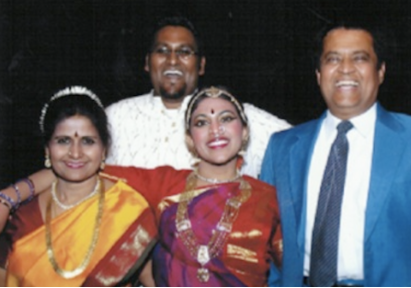Dance has been a part of my life for as long as I could remember. Even before I started dancing, I would run around backstage, watching the dancers donning their make-up and marvel at their gorgeous clothes. I watched them preparing to take on the stage as they ran hand movements before stepping out.
The hours of work put into each dance was clearly visible. The carefully honed choreography, the travel to India for custom stitched dance outfits, the hours of hair and makeup—you could see the care crafted into each dance. You could also see the happiness. Week after week, students came to dance class eager to learn and excited to showcase their talent.
I had a goal of perfection when I was on stage. Seeing awkward young girls transform into self-assured and confident women, left me wondering when I would make that beautiful, graceful transformation.
One of the best aspects of growing up in Natyalaya is the number of opportunities dancers had to hone their skills. We were able to learn from esteemed dancers during summer clinics. Competitions, recitals, religious events, there was always another event to look forward to. I had the benefit of being able to practice not only with my friends in Temple, TX, but I was also able to dance with my friends in Austin. I reveled in the dance dramas, like Antariksha. Slowly, I was learning to transform through dance and finding delight in it.
Growing up with Guru Vinitha as your mother has certainly enriched my view of dance. I wanted to be perfect to show how wonderful my mom was at teaching. All my mom wanted was for me to love and appreciate the beauty of Bharatanatyam. And yet, my drive to become one of those graceful, beautiful dancers became a strict task master. It ordered:
- Sit lower.
- Turn your feet out.
- Don’t drop your arms.
- Look at your hands.
- Remember to smile.
There were so many instructions to keep in mind, it grew hard to keep them straight.
I remember one dance vividly where the drive overcame the dance. During a duet with Rucha Bhatt, we each had a small solo. Rucha’s part was beautifully executed. However, when it came time for my solo, my mind went blank. Beneath all the pressure I’d put on myself, the pleasure of dancing had been forced to the back and the results were terrible. Suddenly I couldn’t remember any of the gestures or steps. In the moment I didn’t know what to do next. I was frozen in disbelief and shame. It is devastating when you have practiced so much and worked so hard for your brain to freeze like that during a performance.
I was so disappointed in myself. I felt I had not only let myself down, but my mom, my friend, and my school. I had ruined the performance. But I realized something very important that day. No one would have known if only I remembered to smile.
While a complicated step is always appreciated, and emotion expressed through dance evokes sentimentality, a smile connects you to your audience and innately brings joy to the dance. To project confidence is a performance of the most integral kind and leading with a smile is sure to beguile your audience.
So, to those learning dance, the best advice I’ve learned, after 20 years of dance, is to remember to smile. Practice your steps, commit them to memory, but keep in mind the joy you feel when dancing and show that to your audience. Therein lies the true beauty of Bharatanatyam.


